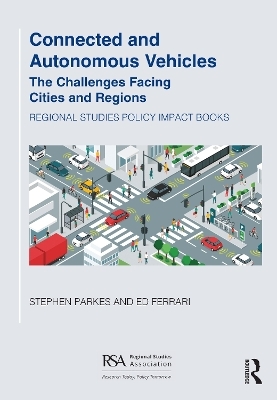
Connected and Autonomous Vehicles
The challenges facing cities and regions
Seiten
2023
Routledge (Verlag)
978-1-032-39211-0 (ISBN)
Routledge (Verlag)
978-1-032-39211-0 (ISBN)
This book views developments around Connected and Autonomous Vehicles (CAVs) through the lens of local policymakers and the towns and cities they represent. The authors discuss levels of preparedness and the different challenges that CAVs will pose for the built environments of cities.
The past decade has seen substantial progress towards the development of Connected and Autonomous Vehicles (CAVs). Accompanying the technological developments, there has been much dialogue around the potential for CAVs to help solve a range of economic, social, and environmental issues. Some of CAVs purported benefits include, for example, greater efficiency in the use of existing transport infrastructure, improved safety through removing human error, and widening access to automobility. However, there are also many potential downsides, and whether and how CAVs will deliver on their promise remains shrouded in much uncertainty and not a small degree of scepticism.
This book views developments around CAVs through the lens of local policymakers and the towns and cities they represent. We argue it is now time to expand the dialogue to include consideration for towns and cities beyond those early adopters to understand how they will fare, and how CAVs might interact with other important policy agendas facing them.
We discuss the different challenges that CAVs will pose for the urban built environment and the required forms of preparedness for these. We also explore how CAVs will interact with other uses and users of cities, including potentially competing efforts to enhance urban wellbeing and liveability. Finally, we consider how responses to CAVs are being developed and what the implications of these are.
This book will appeal to policymakers, practitioners, and academics interested in the potential impacts of CAVs and in understanding more about how they will shape and interact with cities and regions in the near future.
The past decade has seen substantial progress towards the development of Connected and Autonomous Vehicles (CAVs). Accompanying the technological developments, there has been much dialogue around the potential for CAVs to help solve a range of economic, social, and environmental issues. Some of CAVs purported benefits include, for example, greater efficiency in the use of existing transport infrastructure, improved safety through removing human error, and widening access to automobility. However, there are also many potential downsides, and whether and how CAVs will deliver on their promise remains shrouded in much uncertainty and not a small degree of scepticism.
This book views developments around CAVs through the lens of local policymakers and the towns and cities they represent. We argue it is now time to expand the dialogue to include consideration for towns and cities beyond those early adopters to understand how they will fare, and how CAVs might interact with other important policy agendas facing them.
We discuss the different challenges that CAVs will pose for the urban built environment and the required forms of preparedness for these. We also explore how CAVs will interact with other uses and users of cities, including potentially competing efforts to enhance urban wellbeing and liveability. Finally, we consider how responses to CAVs are being developed and what the implications of these are.
This book will appeal to policymakers, practitioners, and academics interested in the potential impacts of CAVs and in understanding more about how they will shape and interact with cities and regions in the near future.
Stephen Parkes is a Research Fellow in the Centre for Regional Economic and Social Research (CRESR) at Sheffield Hallam University, UK. Ed Ferrari is Director of the Centre for Regional Economic and Social Research (CRESR) at Sheffield Hallam University, UK.
1. Introduction 2. The transition to connected and autonomous vehicles 3. The challenges posed by CAVs for the built environment 4. Alignment with concurrent policy agendas promoting liveability 5. Responding to the arrival of increasingly connected and autonomous vehicles 6. Conclusions
| Erscheinungsdatum | 08.02.2023 |
|---|---|
| Reihe/Serie | Regional Studies Policy Impact Books |
| Zusatzinfo | 2 Tables, color; 4 Line drawings, color; 18 Halftones, color; 22 Illustrations, color |
| Verlagsort | London |
| Sprache | englisch |
| Maße | 174 x 248 mm |
| Gewicht | 190 g |
| Themenwelt | Naturwissenschaften ► Geowissenschaften ► Geografie / Kartografie |
| Sozialwissenschaften ► Soziologie | |
| Wirtschaft ► Volkswirtschaftslehre | |
| ISBN-10 | 1-032-39211-8 / 1032392118 |
| ISBN-13 | 978-1-032-39211-0 / 9781032392110 |
| Zustand | Neuware |
| Haben Sie eine Frage zum Produkt? |
Mehr entdecken
aus dem Bereich
aus dem Bereich
über eine faszinierende Welt zwischen Wasser und Land und warum sie …
Buch | Hardcover (2023)
dtv (Verlag)
24,00 €
Buch | Hardcover (2024)
Schweizerbart'sche, E. (Verlag)
24,00 €
Eine Einführung in die spezielle Mineralogie, Petrologie und …
Buch | Hardcover (2022)
Springer Spektrum (Verlag)
59,99 €


